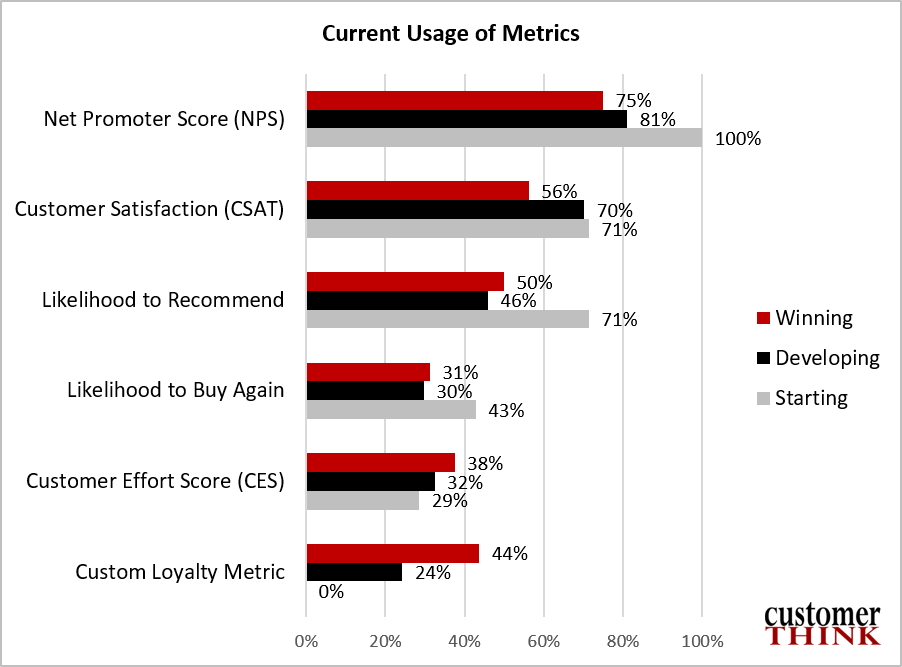NPS, CES, CSAT: Which One is the Best Metric?
NPS, CES, and CSAT are customer loyalty metrics. They’re used to measure the level of loyalty that a customer has toward your brand. Customers are considered loyal when they consistently purchase from your brand over an extended period of time.
How do you get loyal customers? A great customer experience (CX), of course.
In recent years, research by CustomerThink, Forrester, and Gartner have found at least 70% of business leaders believe CX will help their companies differentiate in a world where products and services are increasingly commoditized, and competing based mainly on price is not a viable long-term strategy.
An indisputable key component of a customer experience strategy is the Voice of the Customer (VoC) program, also known as customer voice. It captures, analyzes and reports on all customer feedback—expectations, likes, and dislikes—associated with your company.
In your VoC program, there are two types of customer data that you should collect: structured data and unstructured data. Today, we’ll discuss the three most popular customer loyalty metrics that fall under the structured category—NPS, CES, and CSAT—and the role that each should play in your CX strategy.
An introduction to NPS, CES, and CSAT
Before diving into the value of each metric, it’s important to go over the basics.
Net Promoter Score (NPS)
In 2003, loyalty consultant Fred Reichheld proposed a simple method to measure loyalty, called the Net Promoter Score® (NPS®).
NPS is based on the question “How likely is it that you would recommend this company/product/service to a friend or colleague?” using a scale from 0 (not at all likely) to 10 (extremely likely).
The NPS score is calculated by subtracting the percentage of Detractors from Promoters. Such as: (% Promoters – % Detractors = NPS).
This is a great metric to measure long-term customer satisfaction and loyalty. It’s the big picture metric of customer experience.
Customer Effort Score (CES)
The Customer Effort Score question asks customers their agreement with the statement: “The company made it easy to handle my issue,” using a seven-point scale from 1 = strongly disagree to 7 = strongly agree.
The score is calculated in various ways. A popular approach is to divide the sum of all individual customer effort scores by the number of customers who provided a response. Such as: (Total sum of responses)/(Number of responses) = CES score.
CES is used to measure the level of effort that a customer experiences when they interact with your brand. It’s a transactional, short-term metric for customer experience.
Customer Satisfaction Score (CSAT)
The Customer Satisfaction Score is assessed by asking customers: “How would you rate your overall satisfaction?” with your company and its products, services, and interactions.
A five-point scale is most commonly used, with options very unsatisfied, unsatisfied, neutral, satisfied, and very satisfied.
There are two ways companies can calculate CSAT: an average of 1-5 or by focusing in on the 4-5 responses. GetFeedback recommends using this formula: (Number of 4 and 5 responses) / (Number of total responses) x 100 = % of satisfied customers.
While you can use CSAT as an average, that isn’t as useful as calculating the percentage of those customers who consider themselves satisfied. If you stop and think about it, that makes sense—the metric is looking at the percentage of happy customers specifically.
CSAT is used to measure the customer satisfaction of a specific interaction or event. It’s a short-term satisfaction metric for customer experience.

Which loyalty metric is the best?
The truth is that there isn’t one metric that is better than another. All three add value to your CX program, you just need to use them strategically.
This section will discuss how best to use these three most common customer loyalty metrics. Keep in mind that these are general guidelines and your mileage may vary. Every industry and company has a unique set of characteristics, so consider this as input to your planning process, not a cookbook to implement.
The reputation of each metric
NPS has some challenges because it’s calculated by subtracting two percentages. Which means that two companies can have the same NPS score, but quite different compositions of Promoters and Detractors.
Here is what I mean: An NPS of 20 can be achieved with 60% Promoters minus 40% Detractors or 25% Promoters minus 5% Detractors.
Still, NPS is quite popular in executive circles because it’s easy to understand and communicate the concept of increasing advocacy. As a practical matter, technical issues don’t seem to matter much to brands that use NPS as a high-level measure of brand loyalty.
CSAT is a statistically sound metric. Most people are used to answering the satisfaction question of rating a brand on a 1-5 scale, so it’s easy to understand and implement.
However, the wording of the CSAT question is not standardized, making it difficult to compare scores from different organizations. And, merely satisfied customers is a fairly low bar that may give organizations a false sense of security because it doesn’t necessarily lead to loyalty.
CES has gained popularity as a metric aimed at reducing the effort in customer service or other routine interactions. If the primary value proposition of your brand is fast and easy experiences, such as Amazon, then CES could work well as a brand loyalty indicator. However, for the rest of us, CES is best used in customer service or other routine experiences where low effort is the main loyalty driver.
In general, CES hasn’t been established as the best general-purpose metric for all situations. The main concern is that while easy is a widely desirable CX attribute, it is usually not the sole driver of customer loyalty.
How to best use NPS, CES, and CSAT
Let’s start with the facts.
A 2018 CustomerThink study found that firms may start out using NPS or CSAT, but over time tend to use multiple metrics including composite indicators that can be proven to link to desired business outcomes.
CustomerThink also found that the choice of metrics is not a major factor in CX success, but rather how the organization acts on the insights.
The point I am trying to make is that a company that aggressively acts on customer feedback with a less-than-optimal loyalty metric will outperform those that spend too much time searching for the perfect one number to represent customer loyalty.
Keep this in mind when you’re stressing about whether NPS or CSAT is best to measure a specific interaction.
Now, when it comes to using NPS, CES, and CSAT, the first thing to consider is whether you are measuring the health of the overall customer relationship, or getting feedback after a recent experience or touchpoint.
NPS and CSAT are relationship surveys
Relationship surveys are typically conducted at least annually to get an overall assessment of how customers perceive the organization and the products, services, and support delivered. Some organizations survey more often, but be careful to not overload current customers with survey requests.
NPS and CSAT can both be used effectively for relationship surveys. In addition to the main loyalty question, additional diagnostic questions should be asked about relevant attributes such as product quality, service responsiveness, etc. These should be developed to assess elements of your company’s “brand promise.”
Also, it’s almost always a good idea to ask at least one open-ended question to give customers a chance to explain their ratings, or to share issues not represented in the survey.
As for the length of the survey, there is no magic answer for every situation, but industry experts generally recommend limiting surveys to 10 to 15 questions maximum which can be answered in 10 minutes or less. For deeply invested customers, it’s possible to get good results from longer surveys, especially if you make it clear that customer feedback will be taken seriously.
CSAT and CES are touchpoint surveys
Touchpoint surveys are used to capture feedback after individual customer interaction with different parts of the organization. For example, a pop-up web survey can get feedback as customers or prospects are interacting with a website. Service interactions are another excellent opportunity to ask for feedback, ideally on the same channel that the customer used to get service.
The goal for a touchpoint survey is to understand how well the organization performed at that point in the customer journey. For this goal, CSAT and CES can both work well. The NPS “would you recommend” question can be confusing for customers because referral behavior is usually based on more than just one recent interaction.
Touchpoint surveys should be as short as possible to maximize the response rate. Some experimentation may be required to find the best number of questions and avoid survey fatigue. At Sun Basket, for example, post-service surveys are 5-8 questions, sent to 50% of cases mainly by email. Survey requests are limited to one every 45 days.
Metrics based on CX maturity

The graph above shows that folks who are starting their CX initiatives are heavy users of NPS and Likelihood to Recommend survey questions, but that enthusiasm goes away with maturity.
In fact, folks that fall under winning CX initiatives tend to use NPS and CSAT somewhat less, and Custom Metrics substantially more, than those in a developing stage.
CustomerThink research has found that to the most experienced CX leaders there is no one metric that is best for all situations. Meaning, different types of loyalty require different metrics. For instance, in a study of the telecom industry, loyalty researcher Bob Hayes concluded that retention, new customer growth, and average revenue per customer require different questions.
In conclusion
The big picture is that NPS is most commonly used overall—by 83% of CX initiatives. CSAT isn’t far behind at 69%. On average, companies use three different metrics, while only 19% report using just one metric.
CX leaders shouldn’t pin their hopes on any one metric. Instead, do proper research to select the metrics that predict the desired business outcomes.

Guide to Boosting Customer Loyalty
Learn how to use customer loyalty metrics (NPS, CES, and CSAT) to improve customer experience and increase retention rates.
Business & Finance Articles on Business 2 Community
(58)


